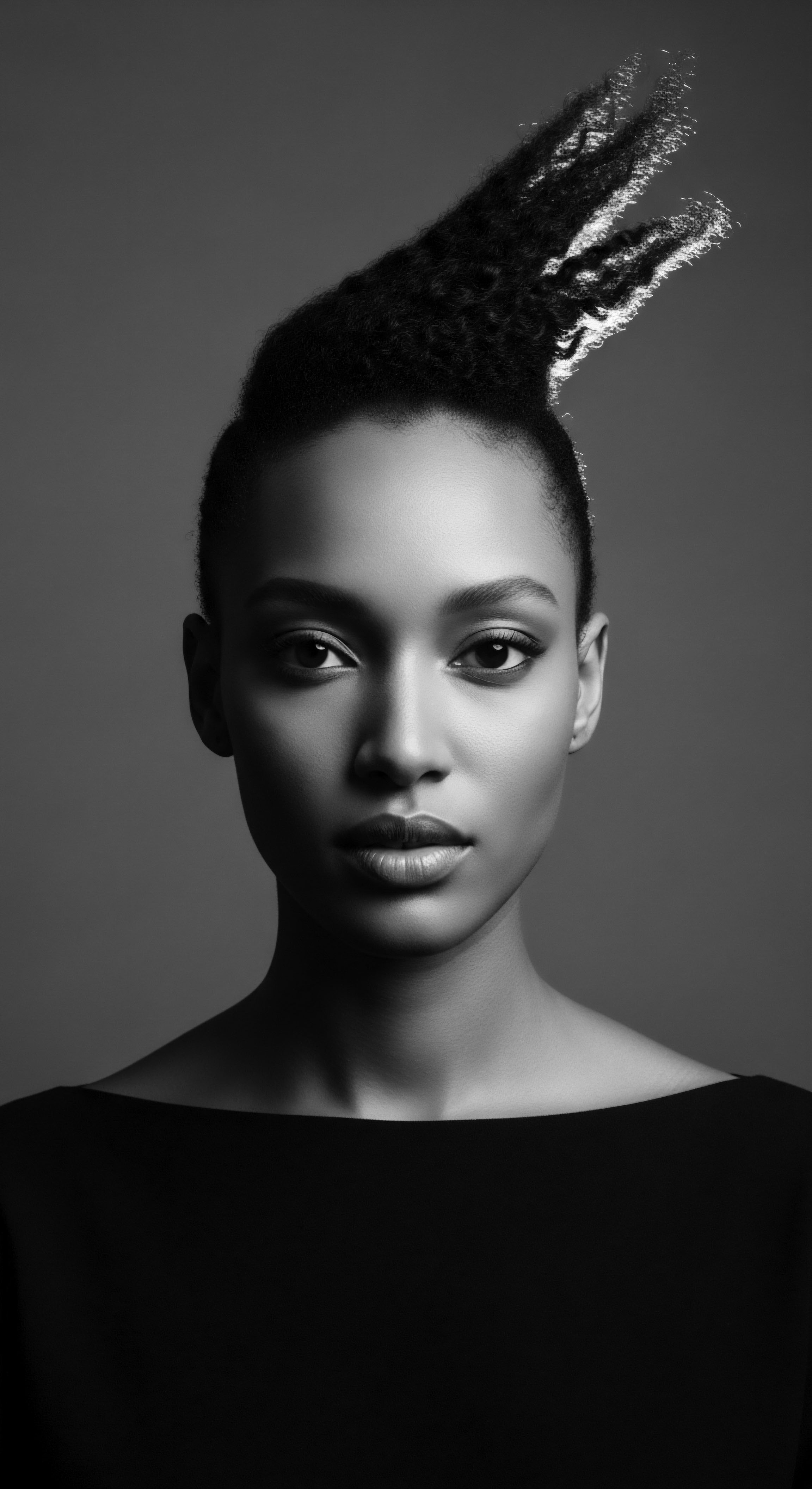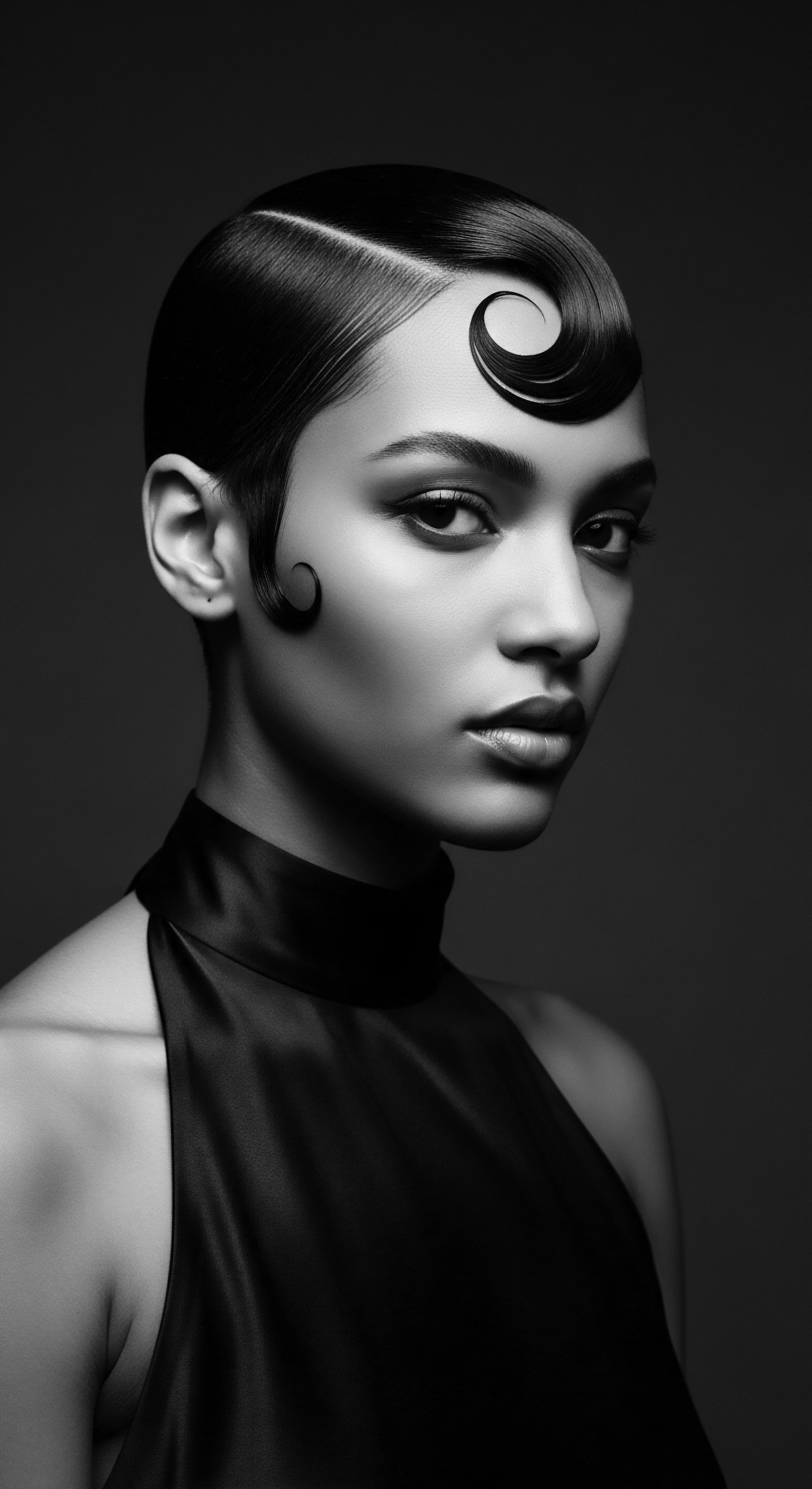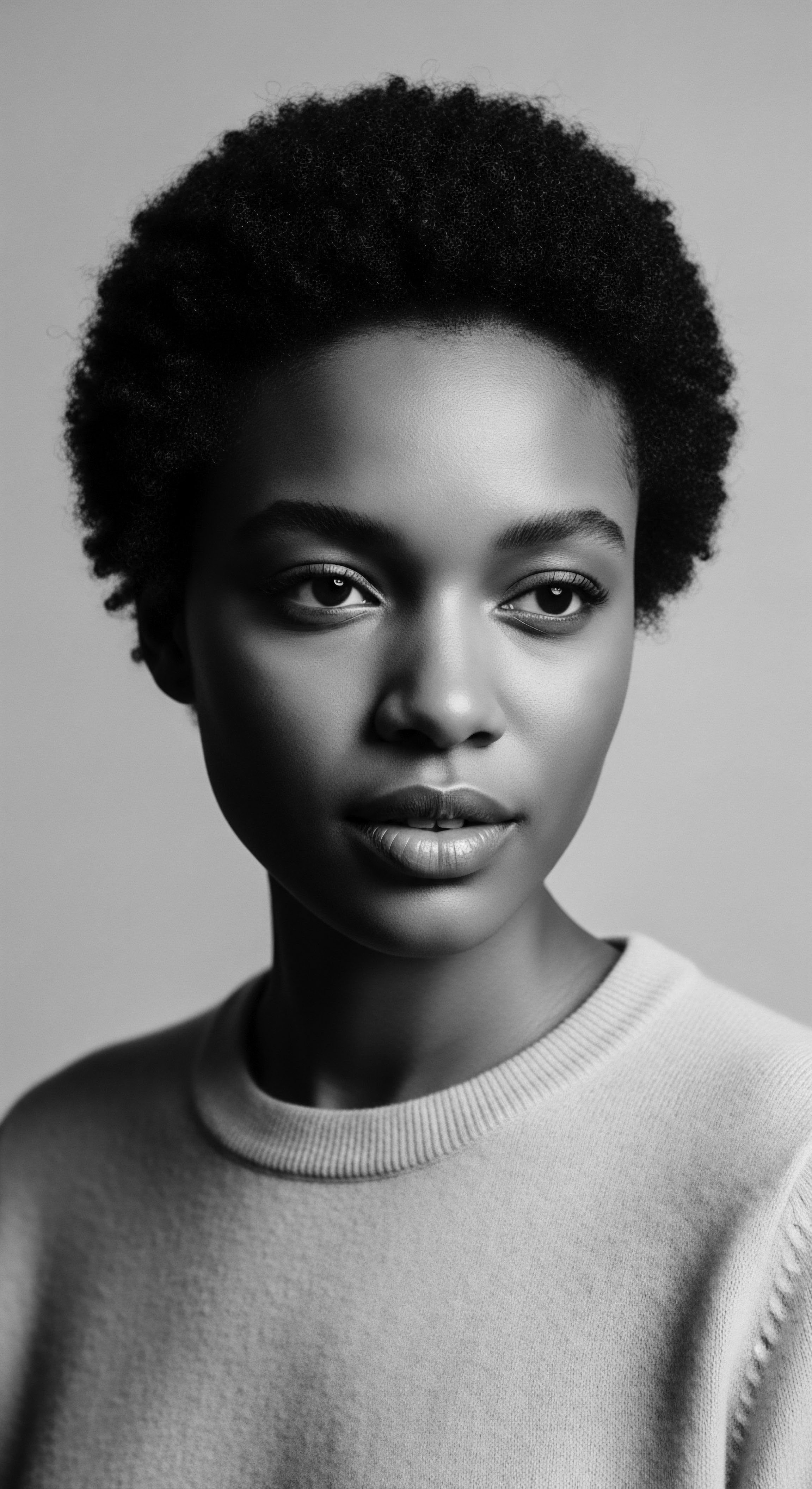
Fundamentals
The concept of Indigenous Hair Sovereignty springs from a deep, enduring reverence for hair as an extension of self, spirit, and ancestral lineage. It is a fundamental assertion of the right of Indigenous and Black communities, alongside those of mixed heritage, to govern their own hair practices, aesthetics, and expressions without external imposition or judgment. This encompasses the freedom to wear, style, and care for one’s hair in ways that honor cultural heritage, spiritual beliefs, and personal identity, unimpeded by Eurocentric beauty standards or oppressive societal norms. Within this primary understanding, hair is more than a mere physical attribute; it serves as a profound connection to the earth, to community, and to the wisdom accumulated over generations.
For countless Indigenous peoples globally, hair embodies a sacred life force, a physical manifestation of thought, spirit, and memory. The length and style of hair often signify a person’s journey, their standing within their community, or their spiritual practices. It is a conduit, allowing for heightened perception and a deeper connectivity to the natural world, drawing sustenance and guidance from the very essence of Mother Earth.
This profound perspective explains why, for many, the mere touch of hair by someone outside their trusted circle is a deeply personal matter, capable of disrupting one’s energetic field. The care given to hair becomes a ceremony in itself, a daily affirmation of connection to creation and to the rich ancestral heritage that courses through each strand.
Indigenous Hair Sovereignty affirms the inherent right to self-determination over one’s hair, recognizing it as a sacred extension of spirit, identity, and ancestral wisdom, free from external control.
Across various Indigenous nations, from the Plains tribes of North America to diverse communities across the African continent, historical accounts affirm the integral role of hair in individual and collective recognition. Styles served as a visual language, conveying age, marital status, tribal affiliation, and even social rank. These expressions were not simply cosmetic; they were deeply integrated into daily life, ceremonial observances, and rites of passage. Traditional care practices, such as washing hair with the cleansing properties of Yucca Root or infusing oils with local botanicals, stand as testament to an intimate knowledge of the land and its offerings, passed down through the ages.

The Roots of Adornment
The adornment of hair, a practice as ancient as humanity itself, was seldom without significance in these heritage-rich cultures. Whether through the intricate weaving of feathers and animal skins by Plains tribes or the embellishment of braids with cowrie shells and beads in West African communities, each element carried specific meaning, reinforcing identity and belonging. These expressions of beauty were intertwined with spiritual devotion, symbolizing protection, wealth, or a connection to deities.

Intermediate
Expanding upon its foundational meaning, Indigenous Hair Sovereignty involves navigating the historical currents that sought to undermine this inherent right, especially for textured hair communities. The colonial project, often marked by a deliberate assault on cultural identity, recognized hair as a powerful marker of selfhood and collective belonging. Acts of forced hair shaving, the imposition of Eurocentric beauty standards, and the criminalization of traditional hairstyles were deliberate strategies to diminish the spirit and sever the connections to ancestral ways of being. Yet, in the face of such adversity, textured hair became a resilient testament to survival, a quiet, potent form of resistance that persisted through generations.
The forced displacement of enslaved Africans across the Middle Passage, for instance, often commenced with the brutal shaving of heads. This act aimed to dehumanize, to strip individuals of their cultural signifiers, and to dismantle their sense of communal identity. However, even within the confines of enslavement, the legacy of ancestral hair practices found ingenious ways to endure. Women braided seeds into their hair, ensuring survival and the continuation of vital food sources in new lands.
Cornrows, far from being mere decoration, became clandestine maps to freedom, intricate guides etched onto scalps, leading the way out of bondage. This historical reality underscores the profound symbolism embedded within Black hair, transforming it into a vessel of survival and a silent, yet powerful, declaration of selfhood.
Despite concerted efforts to suppress traditional hair practices, Black and Indigenous communities transformed hair into a symbol of resilience, using it as a conduit for cultural preservation and covert communication.
For mixed-race individuals, the journey through hair identity frequently presents its own set of complexities, mirroring the intricate blending of their cultural lineages. Their hair, often a unique combination of curl patterns and textures, can become a visible representation of their diverse heritage, yet it also exposes them to pressures to conform to dominant beauty ideals. Discussions within mixed-race communities reveal that hair serves as a particularly telling marker of identity, influencing how individuals perceive themselves and how they are perceived by the world around them. This reality necessitates a reclaiming of personal hair narrative, recognizing the beauty inherent in every coil and wave, a celebration that honors all contributing ancestries.

The Healing Hand of Care
Traditional hair care practices, passed down through matriarchal lines and community elders, hold significant lessons for holistic wellness. These rituals extend beyond mere physical cleansing; they encompass spiritual nourishment and communal bonding. The act of braiding a child’s hair, for example, becomes a moment for sharing stories, instilling values, and reinforcing the intimate relationships that bind families and tribes. It is a tender exchange, solidifying a sense of belonging and cultural continuity.
Consider the preparation of hair treatments from natural elements of the land. The sap of certain trees, the pulp of fruits, or infusions from specific herbs provided not only cleansing and conditioning but also carried the spiritual essence of the earth itself. These ancient remedies, such as the use of Yucca Root as a natural shampoo or plant-based pomades for conditioning, were meticulously applied, acknowledging hair as a living extension requiring mindful attention. This deep understanding of natural chemistry, observed and refined over centuries, offers a profound blueprint for contemporary holistic hair care.
The ancestral knowledge embedded in these practices offers a compelling narrative for understanding textured hair today. It underscores the importance of gentle methods, natural ingredients, and a patient approach to care that honors the unique structure of each strand. The very act of care becomes a meditation, a mindful practice connecting the individual to a legacy of wisdom.
| Ancestral Practice Yucca Root Cleansing |
| Traditional Application (Heritage Context) Used by various North American Indigenous tribes for its natural lathering and cleansing properties, often seen as a spiritual purifier. |
| Contemporary Relevance for Textured Hair Provides a gentle, sulfate-free alternative to harsh shampoos, supporting scalp health and moisture retention for coils and curls. |
| Ancestral Practice Herbal Oil Infusion |
| Traditional Application (Heritage Context) African and Indigenous communities infused oils with botanicals like moringa or shea butter for conditioning, strength, and spiritual protection. |
| Contemporary Relevance for Textured Hair Deep conditioning and scalp massages promote blood circulation, follicle health, and reduce breakage, honoring hair as a sacred antenna. |
| Ancestral Practice Communal Braiding |
| Traditional Application (Heritage Context) An intimate social ritual in many African societies, fostering storytelling, knowledge transmission, and strengthening familial bonds. |
| Contemporary Relevance for Textured Hair Builds community and intergenerational connection, offering a space for shared care, emotional support, and the preservation of styling techniques. |
| Ancestral Practice Protective Styling with Natural Elements |
| Traditional Application (Heritage Context) Adorning and securing hair with clay, plant fibers, or animal hair for protection from elements and symbolic expression. |
| Contemporary Relevance for Textured Hair Minimizes manipulation and environmental damage, aligning with principles of low-tension styling and encouraging natural growth for textured hair. |
| Ancestral Practice These practices illuminate a continuous thread of wisdom, where ancient care methods offer profound insights for nurturing textured hair in the present day, emphasizing connection to heritage. |

Academic
The academic definition of Indigenous Hair Sovereignty delineates an expansive domain of self-determination, recognizing hair as a critical site of cultural production, historical memory, and ontological being for Indigenous, Black, and mixed-race communities. It encompasses the inherent, unceded right to define, maintain, and express identity through hair practices, resisting colonial erasures and challenging contemporary systems of racialized discrimination. This conceptualization moves beyond mere aesthetic choice, positioning hair as a tangible manifestation of collective and individual autonomy, intimately interwoven with struggles for social justice, decolonization, and holistic well-being.
Historically, the policing of textured hair has served as a potent tool of subjugation, strategically deployed to enforce social hierarchies and undermine self-worth. The transatlantic slave trade marked a profound rupture, as the deliberate shaving of enslaved Africans’ heads aimed to dislocate them from their spiritual and communal heritage, stripping away visible markers of identity. This act of violence was not merely hygienic; it was a calculated assault on the personhood and cultural continuity of millions. Yet, astonishing acts of resilience emerged from this brutal reality.
Enslaved women, through ingenious ingenuity, braided Rice Seeds into their hair before forced voyages, ensuring the survival of staple crops and a fragment of their homeland’s agricultural memory on foreign soil. This powerful act symbolizes the enduring spirit of hair sovereignty as a conduit for material and cultural survival, a testament to an unyielding will to preserve life and legacy.
Following emancipation, the struggle for hair sovereignty continued, particularly for Black women in the Americas, through the imposition of restrictive social codes. A particularly striking example is the Tignon Laws of 1786 in Spanish Colonial Louisiana. These ordinances mandated that free women of color wear a tignon, a specific head covering, effectively concealing their elaborate hairstyles and textured hair in public. The intent was clear ❉ to visually differentiate and subordinate free Black women, particularly those who had accrued wealth or social standing, by forcing them to conform to a prescribed modesty that undermined their visible autonomy.
However, in an astounding display of defiance, these women transformed the tignon into a fashion statement, using vibrant fabrics, intricate wrapping techniques, and artful adornments that subverted the law’s oppressive intent. They reclaimed visual agency, demonstrating that even under duress, the spirit of hair sovereignty could find expression through creative resistance. This historical incident powerfully illustrates the dynamic interplay between oppressive legislation and community-led reappropriation, where hair becomes a battleground for dignity and self-expression.
Contemporary academic discourse further elucidates the deep-seated psychological impacts of hair discrimination, particularly on Black and mixed-race individuals. Research, such as that conducted by psychologist Afiya Mbilishaka, has consistently revealed that experiences of hair discrimination extend beyond public spaces into intimate family settings and educational environments. This systemic bias, which often favors looser curl patterns or straightened hair, places an additional psychological burden on those with textured hair.
The pressure to conform to Eurocentric beauty ideals, frequently perpetuated through media representation and societal norms, can lead to internalized negativity and profound feelings of inadequacy regarding one’s natural hair. This internal struggle for acceptance, often beginning in childhood, profoundly impacts self-esteem and identity formation.
Hair discrimination, deeply rooted in historical oppression, continues to impose significant psychological burdens, influencing self-perception and cultural connection within textured hair communities.

Hair as a Socio-Political Medium
The significance of hair in Black and Indigenous cultures as a socio-political medium cannot be overstated. During the Civil Rights Movement, the Afro hairstyle emerged as a potent symbol of Black pride, unity, and resistance against dominant beauty standards. Individuals like Angela Davis and members of the Black Panther Party popularized the Afro, transforming it into an emblem of empowerment and a visible statement of solidarity with African roots.
This shift marked a conscious rejection of chemical relaxers and heat straightening, embracing natural texture as a political act of self-acceptance and defiance. The movement underscored that hair choice was not merely personal; it was a declaration of cultural allegiance and a challenge to systemic racism.
For mixed-race individuals, their hair often embodies a complex interplay of heritage, presenting a visible manifestation of their diverse genetic makeup. This can lead to unique challenges, as stylists may lack the expertise to care for varied curl patterns, forcing individuals into damaging straightening routines or a feeling of being unrepresented. A study on American multiracial women indicated that many experience “lifelong struggles with styling their curly hair” and frequently “resort to intense straightening” due to a lack of competency among hairstylists.
This points to a broader societal deficit in recognizing and valuing diverse hair textures, reinforcing the need for hair sovereignty to extend to professional and commercial spheres. The movement towards hair sovereignty for mixed-race individuals becomes a quest for acknowledgment, for skilled care that honors their unique heritage, and for a world where their hair is celebrated as a beautiful testament to intersectional identity.

The Science of Hair and Identity
From a scientific perspective, textured hair possesses unique structural properties that underscore the necessity for specialized care, knowledge of which has often been preserved through ancestral practices. The elliptical cross-section of highly coiled hair, compared to the rounder cross-section of straight hair, results in more cuticle layers and points of stress along the strand. This inherent structure, while visually stunning, makes textured hair more prone to dryness and breakage without proper moisture and gentle handling.
Traditional practices, such as the consistent application of natural oils and the communal braiding of hair into protective styles, often reflect an intuitive understanding of these biological realities. These historical methods minimized manipulation, provided external lubrication, and allowed the hair to retain its natural moisture, thereby reducing mechanical stress.
The psychological dimension of hair sovereignty is further illuminated by the phenomenon of Hair Fluidity and Performance of Identity. As demonstrated in a study on Black and mixed-race women, hair textures and styles are dynamically employed to re/negotiate and perform identities across different social contexts. This strategic presentation of hair reveals a sophisticated engagement with societal expectations and personal self-perception. For instance, individuals might adopt a particular hairstyle to blend into a professional environment perceived as favoring straightened hair, while reverting to natural styles in spaces where cultural expression is celebrated.
This constant negotiation highlights the psychological toll of external pressures and the enduring significance of hair as a tool for self-definition and social navigation. The consistent finding that natural, Afro-textured hair is often perceived as less professional or attractive in some settings underscores the deep-seated biases that hair sovereignty movements seek to dismantle. The pursuit of hair sovereignty, then, is a pursuit of psychological liberation, allowing individuals to align their external presentation with their internal sense of self and heritage without fear of penalty.
- Colonial Erasure Tactics ❉ The systematic shaving of hair by slave owners represented a deliberate attempt to sever spiritual and cultural ties, aiming to dehumanize enslaved populations.
- Legal Subjugation ❉ Laws like the Tignon Laws in 18th-century Louisiana specifically targeted Black women’s hair, attempting to control their public image and social standing.
- Contemporary Discrimination ❉ Modern forms of hair discrimination persist in schools and workplaces, creating adverse psychological and educational impacts on individuals with textured hair.

Challenges to Hair Sovereignty and Pathways Forward
The journey towards full Indigenous Hair Sovereignty is an ongoing process that requires dismantling ingrained biases and fostering widespread cultural literacy. The persistent presence of hair discrimination in various societal spheres, from educational institutions to corporate environments, serves as a stark reminder of the work that remains. Instances of students being disciplined for wearing natural hairstyles, or professionals facing career limitations due to their hair choices, echo historical patterns of control and assimilation.
These contemporary challenges highlight the need for legislative action, like the CROWN Act in the United States, which seeks to prohibit discrimination based on hair texture and protective hairstyles. Such legal frameworks provide a necessary scaffold for protecting the inherent right to hair sovereignty, but they must be accompanied by deeper societal shifts in perception and appreciation.
A critical aspect of advancing hair sovereignty involves a return to, and re-education about, the ancestral wisdom embedded in traditional hair care practices. Modern cosmetic science, with its focus on ingredients and product efficacy, can learn immensely from the holistic approaches of Indigenous and African traditions. These ancient practices often combined nourishing botanical ingredients with mindful rituals, fostering not just external beauty but also internal well-being.
Understanding the biological uniqueness of textured hair and validating traditional methods with scientific inquiry can create a more inclusive and effective landscape for hair care. It offers a path to integrate ancestral knowledge with contemporary understanding, fostering a hair culture that celebrates authenticity and well-being.
Moreover, the recognition of Indigenous Hair Sovereignty contributes to the broader movement for self-determination for Indigenous peoples globally. Just as Indigenous nations fight for autonomy over their lands and resources, so too do they assert their right to cultural self-governance, of which hair is an inseparable component. This includes the right to practice traditional ceremonies involving hair, to pass down hair knowledge intergenerationally, and to resist any attempts to standardize or devalue their unique hair expressions. It is a declaration that their cultural heritage is not merely a relic of the past but a vibrant, living force that continues to shape identity and inform the future.

Reflection on the Heritage of Indigenous Hair Sovereignty
The journey through Indigenous Hair Sovereignty, tracing its echoes from the source of ancient practices to its vibrant role in shaping contemporary identities, reveals a profound, unbroken lineage of care and spiritual connection. Every coil, every braid, every strand of textured hair holds a narrative of enduring resilience, a whisper of ancestral wisdom that has transcended centuries of attempted erasure. It is a living archive, a testament to the power of self-definition in the face of imposed norms. This deep well of heritage offers not only a mirror reflecting our past but also a compass guiding us toward a future where every individual can stand in their full, authentic beauty, deeply rooted in the knowledge of where they come from.
The very act of nurturing textured hair, whether through time-honored rituals or scientifically informed care, becomes a conscious participation in this ancestral legacy. It is a tender thread connecting us to grandmothers who knew the healing properties of the earth’s botanicals and to communities where hair was a map, a symbol of status, or a secret message of freedom. This ongoing conversation between elemental biology and ancient traditions, between the individual’s inner landscape and their outward expression, paints a vivid portrait of identity unfolding. The unbound helix of textured hair, therefore, symbolizes more than a physical form; it embodies an enduring spirit, a quiet revolution, and a celebration of a heritage that continually reaffirms its powerful presence in the world.

References
- Byrd, Ayana, and Lori L. Tharps. Hair Story ❉ Untangling the Roots of Black Hair in America. St. Martin’s Press, 2014.
- Chimbiri, K.N. The Story of Afro Hair ❉ 5000 Years of History, Fashion and Styles. Scholastic, 2022.
- Dabiri, Emma. Twisted ❉ The Tangled History of Black Hair Culture. Harper Perennial, 2020.
- Mbilishaka, Afiya, and Rachel Apugo. “The Psychology of Black Hair ❉ Unpacking the Cultural and Social Significance of Hair for Black Women.” Journal of Black Psychology, 2020.
- Moses, L.G. Wild West Shows and the Images of American Indians, 1883-1933. University of New Mexico Press, 1996.
- Patton, Tracey Owens. African-American Hair as Culture and Commerce. Brill, 2006.
- Robinson, Nicole. “The Good Hair/Bad Hair Dilemma.” The Black Scholar, 2011.
- Thompson, Cheryl. Beauty in a Box ❉ Detangling the Roots of Canada’s Black Beauty Culture. Wilfrid Laurier University Press, 2017.
- Williams, Regina. “The Politics of Black Hair ❉ Hair as a Site of Identity and Resistance.” Souls ❉ A Critical Journal of Black Politics, Culture, and Society, 2019.
- Wyatt, Gail, and Jacqueline Scott. “The Politics of Black Hair ❉ Cultural Identity and Self-Esteem.” Journal of Black Studies, 2003.
